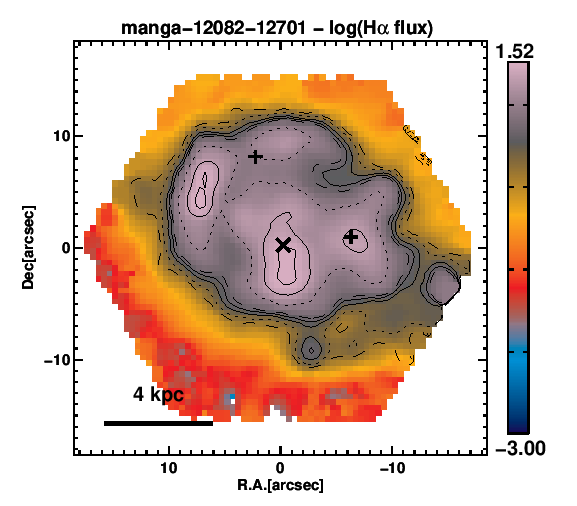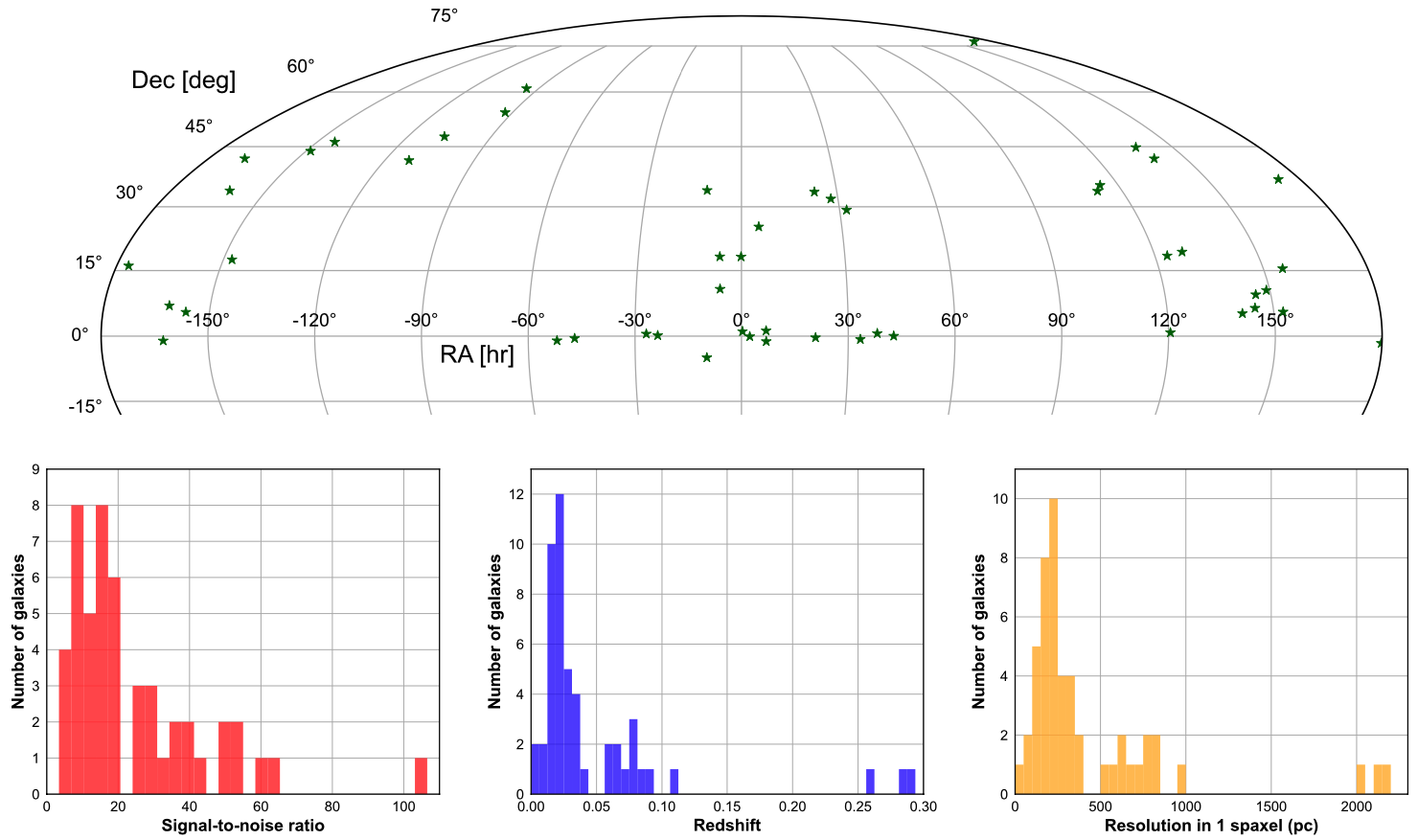Supernova Environments
Contact

| Lluís Galbany |
|---|
| Institute of Space Sciences (ICE-CSIC) |
Summary
This program targetted 50 galaxies that hosted supernovae (SNe) of different types that are underrepresented in the main sample, and for which photometric and spectroscopic data is publicly available, enabling correlations between observed SN properties and galaxy environmental parameters.
Finding Targets
An object whose MANGA_TARGET3 or MNGTARG3 value includes one or more of the bitmasks in the following table was targeted for spectroscopy as part of this ancillary target program. See SDSS bitmasks to learn how to use these values to identify objects in this ancillary target program.
| Program (bit name) | Bit number | Target Description |
|---|---|---|
| SN_ENV | 22 | SNe hosts selected by mechanism described below |
Description
Supernovae (SNe) play a key role in our understanding of stellar evolution, galaxy evolution, and cosmology, but despite their importance, the exact physical mechanisms involved in the explosion and the nature of the progenitor stars of each SN type are not yet completely understood. SNe are broadly divided into core collapse SNe (CCSNe), which are triggered by the gravitational collapse of the iron core of young massive stars (≥8 M⊙), and SNe Ia, which result from thermonuclear explosions of carbon–oxygen white dwarfs. Both types show a wide range of photometric and spectroscopic properties, and the main source of this heterogeneity is differences in the progenitor star characteristics (e.g., mass, age, and metallicity). Recently, there is an increasing interest in a new kind of explosion, dubbed superluminous SNe, that are 10 to 100 times brighter than regular SNe.
Despite concerted efforts, only a few CCSN progenitors have been directly detected in pre-explosion images (see Smartt et al. 2016 for a review), so alternative methods such as the characterization of the local environments where SN explode have become crucial to constrain SN progenitor systems. The advent of wide field integral-field spectrography (IFS) represents a leap in environmental studies of SN host galaxies, allowing us to characterise the local and global properties of the SN host galaxies simultaneously.
The CALIFA survey compiled one of the first statistical samples of nearby galaxies observed with this technique. Although the galaxy selection was performed by a combination of galaxy redshift and size (introducing several selection biases) and not motivated by SN science, Galbany et al. (2014, 2016) have compiled a sample of 115 CALIFA galaxies where 132 SNe of all types (47 type II, 27 type Ib/c+IIb, 58 Ia) had been discovered, which was the largest compilation of SN environments studied with IFS to date. Studying the star-formation rate (SFR) at the positions of different supernova types, they found that the SFR is higher at SNe Ibc positions compared to SNII, pointing to a higher mass and younger progenitor stars for SNe Ibc. Also, they found statistically significant differences in the local metallicities at SNe Ic and SNe Ib positions. This indicates that metallicity-driven winds play an important role in distinguishing their progenitors, and favours a single star scenario for SNe Ic but binary systems for SNe Ib. For SNe Ia, they found that all galaxy integrated properties were statistically indistinguishable from the local properties at SNe Ia positions. This has important consequences for SN Ia cosmology because it means that integrated properties can be used a proxy for local properties, which cannot be observed at high redshift studies due to the lack of spatial resolution.
Although those were important results, they were affected by the selection bias of the CALIFA survey, since the galaxies were selected to answer other science questions and do not represent an unbiased selection of SN hosts. Also, the lack of precise spectral classification of SNe subtypes limited their ability to place constraints on different progenitor scenarios. The aim of this ancillary program is to construct a sample that alleviates these issues by using MaNGA to build up the number of IFS observations of galaxies that hosted well-classified SNe of different subtypes with good photometric follow-up. This would allow for the characterisation of the stellar populations and ionizing gas properties at the locations of the SNe. Most importantly, MaNGA would be able to put the SNe host regions in context relative to other regions and the overall galaxy properties. Ultimately, these types of comparisons will provide critical constraints on the progenitor scenarios that lead to different supernova subtypes.
Because the Galbany et al. sample was beholden to the CALIFA (Sánchez et al. 2012) target selection algorithm and not selected with SN hosts specifically in mind, it suffers from some biases that impact their conclusions about progenitor scenarios. In particular, the lack of low mass galaxies (<10^10 M⊙) means that their sample is missing low metallicity galaxies and host regions, a critical regime for testing theories of SN progenitors because of the strong metallicity dependence of stellar mass loss. We will also be able to study SNe at higher redshifts (∼0.03 compared to ∼0.015), so the extended wavelength coverage of MaNGA relative to CALIFA (from 700 nm to 1 μm) will enable us to uniformly measure additional emission lines, especially [S II] λλ6716,31, He I λ7065, [Ar III] λ7135, [O II] λλ7320,30, [Ar III] λ7751, and [S III] λ9068, stellar absorption features such as the Ca II triplet (8498, 8542 and 8662 A), and better fit the underlying stellar population.
Target Selection
We selected our targets starting from the publicly available SN list from the Open Supernova Catalogue (OSC, >35000 objects). In order to select SNe with definite subtypes, we applied the following cuts [in brackets the number of SNe after the cut]:
- SNe that have a definite spectral type [14225]
- SNe with at least 1 spectrum available [951]
- SNe with dec > -10 deg accessible from APO [681]
- SNe with extensive photometric follow-up, in order to correlate SN and galaxy properties [163]
- SNe that have not already been observed by MaNGA (as of 2016 Nov 1st) or with other IFS [146]
- SNe whose host galaxy is not larger than the field of view of the largest MaNGA IFU or that would not cover the SN location [50].
After these cuts, the sample contains 50 SNe that are useful for our project, with the following types: 5 Ia-02cx, 2 Ia-91bg, 4 Ia-91T, 8 Ib, 4 Ibn, 13 Ic, 3 IcBL, 2 IIb, 5 IIn, 2 SLSN I, and 2 SLSN II. Their projection in the sky in the RA vs Dec space is shown in the figure below. Any fraction of this sample would contribute to an improvement of the current IFU host galaxy data set.

REFERENCES
Galbany, L. et al., 2014, A&A, 572, 38
Galbany, L. et al., 2016, A&A, 591, 48
Maoz, D., et al., 2014, ARA&A, 52, 107
Sánchez, S. F., et al., 2012, A&A, 538, 8
Smartt, S., 2016, PASA, 32, 16


